Timing and Metamorphic Evolution of the Ross Orogeny in and around the Mountaineer Range, Northern Victoria Land, Antarctica
Abstract
:1. Introduction
2. Geological Outline
3. Field Occurrence and Relationship
4. Analytical Methods
5. Zircon U–Pb Geochronology
6. Metamorphic P–T Estimation
6.1. Amphibolite (SB173B) from the Dessent Unit
6.2. Amphibolite (SB174B) from the Dessent Unit
6.3. Amphibolite (SB176B) from the Dessent Unit
7. Discussion
7.1. Possible Provenance of Detrital Zircons in the Mt. Murchison Gneisses (WT)
7.2. Early Paleozoic Metamorphic Phase (Ross Orogeny) in the Mountaineer Range
7.3. Possible Tectonic Model for the Ross Orogeny in the Mountaineer Range
8. Conclusions
Supplementary Materials
Author Contributions
Funding
Acknowledgments
Conflicts of Interest
References
- Boger, S.D.; Wilson, C.J.L.; Fanning, C.M. Early Paleozoic tectonism within the East Antarctic craton: The final suture between east and west Gondwana? Geology 2001, 29, 463–466. [Google Scholar] [CrossRef]
- Meert, J.G. A synopsis of events related to the assembly of eastern Gondwana. Tectonophysics 2003, 362, 1–40. [Google Scholar] [CrossRef]
- Boger, S.D.; Miller, J.M. Terminal suturing of Gondwana and the onset of the Ross-Delamerian Orogeny: The cause and effect of an Early Cambrian reconfiguration of plate motions. Earth Planet. Sci. Lett. 2004, 219, 35–48. [Google Scholar] [CrossRef]
- Collins, A.S.; Pisarevsky, S.A. Amalgamating eastern Gondwana: The evolution of the Circum-Indian Orogens. Earth Sci. Rev. 2005, 71, 229–270. [Google Scholar] [CrossRef]
- Boger, S.D. Antarctica—Before and after Gondwana. Gondwana Res. 2011, 19, 335–371. [Google Scholar] [CrossRef]
- Torsvik, T.H.; Cocks, L.R.M. Gondwana from top to base in space and time. Gondwana Res. 2013, 24, 999–1030. [Google Scholar] [CrossRef]
- Fitzsimons, I.C.W. A review of tectonic events in the East Antarctic Shield and their implications for Gondwana and earlier supercontinents. J. Afr. Earth Sci. 2000, 31, 3–23. [Google Scholar] [CrossRef]
- Harley, S.L. Archaean-Cambrian crustal development of East Antarctica: Metamorphic characteristics and tectonic implications. In Proterozoic East Gondwana: Supercontinent Assembly and Breakup; Yoshida, M., Windley, B.E., Dasgupta, S., Eds.; Geological Society of London Special Publication: London, UK, 2003; Volume 206, pp. 203–230. [Google Scholar]
- Kamenev, E.N.; Maslov, V.A.; Semenov, V.S.; Kurinin, R.G.; Mikhailov, V.M.; Alekseev, N.L.; Kamenev, I.A.; Semenov, S.V. Structure and metamorphism of the Antarctic Shield. Geotectonics 2013, 47, 115–130. [Google Scholar] [CrossRef]
- Dalziel, I.W.D. Neoproterozoic-Paleozoic geography and tectonics: Review, hypothesis, environmental speculation. Geol. Soc. Am. Bull. 1997, 109, 16–42. [Google Scholar] [CrossRef]
- Cawood, P.A. Terra Australis Orogen: Rodinia breakup and development of the Pacific and Iapetus margins of Gondwana during the Neoproterozoic and Paleozoic. Earth Sci. Rev. 2005, 69, 249–279. [Google Scholar] [CrossRef]
- Cawood, P.A.; Buchan, C. Linking accretionary orogenesis with supercontinent assembly. Earth Sci. Rev. 2007, 82, 217–256. [Google Scholar]
- Pankhurst, R.J.; Vaughan, A.P.M. The tectonic context of the Early Palaeozoic southern margin of Gondwana. In Early Palaeozoic Peri-Gondwana Terranes: New Insights from Tectonics and Biogeography; Basset, M.G., Ed.; Geological Society of London Special Publication: London, UK, 2009; Volume 325, pp. 171–176. [Google Scholar]
- Foden, J.; Elburg, M.A.; Dougherty-Page, J.; Burtt, A. The timing and duration of the Delamerian Orogeny: Correlation with the Ross Orogen and implications for Gondwana assembly. J. Geol. 2006, 114, 189–210. [Google Scholar]
- Bomparola, R.M.; Ghezzo, C. Inside the Granite Harbour Intrusives of Northern Victoria Land: Timing and origin of the intrusive sequence. In Online Proceedings of the 10th ISAES X: USGS Open-File Report 2007-1047; Extended Abstract 043; U.S. Geological Survey: Reston, VA, USA; The National Academies: Washington, DC, USA, 2007; 4p. [Google Scholar]
- Shaanan, U.; Rosenbaum, G.; Sihombing, F.M.H. Continuation of the Ross-Delamerian Orogen: Insights from eastern Australian detrital-zircon data. Aust. J. Earth Sci. 2017, 65, 1123–1131. [Google Scholar]
- Siddoway, C.S. Tectonics of the West Antarctic Rift System: New light on the history and dynamics of distributed intracontinental extension. In Proceedings of the 10th International Symposium on Antarctic Earth Sciences, Santa Barbara, CA, USA, 26 August–1 September 2007; U.S. Geological Survey: Washington, DC, USA, 2008. [Google Scholar]
- Burton-Johnson, A.; Riley, T.R. Autochthonous v. accreted terrane development of continental margins: A revised in situ tectonic history of the Antarctic Peninsula. J. Geol. Soc. 2015, 172, 822–835. [Google Scholar]
- Elliot, D.H. The geological and tectonic evolution of the Transantarctic Mountains: A review. In Antarctic Palaeoenvironments and Earth-Surface Processes; Hambrey, M.J., Baker, P.F., Barrett, P.J., Bowman, V., Davies, B., Smellie, J.L., Tranter, M., Eds.; Geological Society of London Special Publication: London, UK, 2013; Volume 381, pp. 7–35. [Google Scholar]
- Jordan, T.A.; Riley, T.R.; Siddoway, C.S. The geological history and evolution of West Antarctica. Nat. Rev. Earth Environ. 2020, 1, 117–133. [Google Scholar]
- Jokat, W.; Boebel, T.; König, M.; Meyer, U. Timing and geometry of early Gondwana breakup. J. Geophys. Res. 2003, 108, 2848. [Google Scholar] [CrossRef]
- Mueller, C.O.; Jokat, W. The initial Gondwana break-up: A synthesis based on new potential field data of the Africa-Antarctica Corridor. Tectonophysics 2019, 750, 301–328. [Google Scholar]
- Williams, S.E.; Whittaker, J.M.; Halpin, J.; Müller, R.D. Australian-Antarctic breakup and seafloor spreading: Balancing geological and geophysical constraints. Earth Sci. Rev. 2019, 188, 41–58. [Google Scholar]
- Brehrendt, J.C.; LeMasurier, W.E.; Cooper, A.K.; Tessensohn, F.; Trébu, A.; Damaske, D. Geophysical studies of the West Antarctic Rift System. Tectonics 1991, 10, 1257–1273. [Google Scholar]
- Granot, R.; Cande, S.C.; Stock, J.M.; Damaske, D. Revised Eocene-Oligocene kinematics for the West Antarctic rift system. Geophys. Res. Lett. 2013, 40, 279–284. [Google Scholar]
- Goodge, J.W. Geology and tectonic evolution of the Transantarctic Mountains, from ancient to recent enigma. Gondwana Res. 2020, 80, 5–122. [Google Scholar]
- Siddoway, C.S. Antarctica. In Encyclopedia of Geology; Elsevier Science: Amsterdam, The Netherlands, 2020. [Google Scholar] [CrossRef]
- Goodge, J.W.; Williams, I.S.; Myrow, P. Provenance of Neoproterozoic and lower Paleozoic siliciclastic rocks of the central Ross orogen, Antarctica: Detrital record of rift-, passive-, and active-margin sedimentation. Geol. Soc. Am. Bull. 2004, 116, 1254–1279. [Google Scholar] [CrossRef]
- Goodge, J.W. Metamorphism in the Ross orogeny and its bearing on Gondwan margin tectonics. In Convergent Margin Terranes and Associated Region: A Tribute to W.G. Ernst; Cloos, M., Carlson, W.D., Gibert, M.C., Liu, J.G., Sorensen, S.S., Eds.; Geological Society of America Special Paper: Boulder, CO, USA, 2007; Volume 419, pp. 185–203. [Google Scholar]
- Rocchi, S.; Di Vincenzo, G.; Ghezzo, C.; Nardini, I. Granite-Lamprophyre connection in the latest stages of the early Paleozoic Ross Orogeny (Victoria Land, Antarctica). Geol. Soc. Am. Bull. 2009, 121, 801–819. [Google Scholar] [CrossRef]
- Rochhi, S.; Bracciali, L.; Gemelli, M.; Ghezzo, C. Arc accretion to the early Paleozoic Antarctic margin of Gondwana in Victoria Land. Gondwana Res. 2011, 19, 594–607. [Google Scholar]
- Capponi, G.; Crispini, L.; Meccheri, M. Structural history and tectonic evolution of the boundary between the Wilson and Bowers terranes, Lanterman Range, northen Victoria Land, Antarctica. Tectonophysics 1999, 312, 249–266. [Google Scholar]
- Capponi, G.; Kleinschmidt, G.; Pertusati, P.C.; Ricci, C.A.; Tessensohn, F. Terrane relationships in the Mariner Glacier area of Northern Victoria Land, Antarctica. In Aspects of a Suture Zone the Mariner Glacier Area, Antarctica; Tessensohn, F., Ricci, C.A., Eds.; Geologisches Jahrbuch: Hannover, Germany, 2003; Volume B85, pp. 49–78. [Google Scholar]
- Ricci, C.A.; Tessensohn, F. The Lanterman-Mariner Suture: Antarctic evidence for active margin tectonics in Paleozoic Gondwana. In Aspects of a Suture Zone the Mariner Glacier Area, Antarctica; Tessensohn, F., Ricci, C.A., Eds.; Geologisches Jahrbuch: Hannover, Germany, 2003; Volume B85, pp. 305–332. [Google Scholar]
- Roland, N.W.; Läufer, A.L.; Sossetti, F. Revision of the terrane model of Northern Victoria Land (Antarctica). Terra Antarct. 2004, 11, 55–65. [Google Scholar]
- Tessensohn, F.; Hunjes-Kunst, F. Northern Victoria Land terranes, Antarctica: Far-travelled or local products? In Terrane Processes at the Margins of Gondwana; Vaughan, A.P.M., Leat, P.T., Pankhurst, R.J., Eds.; Geological Society of London Special Publications: London, UK, 2005; Volume 246, pp. 275–291. [Google Scholar]
- Federico, L.; Capponi, G.; Crispini, L. The Ross Orogeny of the transantarctic mountains: A Northern Victoria Land perspective. Int. J. Earth Sci. 2006, 95, 759–770. [Google Scholar] [CrossRef]
- Rosseti, F.; Vignaroli, G.; Di Vincenzo, G.; Gerdes, A.; Ghezzo, C.; Theye, T.; Balsamo, F. Long-Lived orogenic construction along the paleo-Pacific margin of Gondwana (Deep Freeze Range, Northern Victoria Land, Antarctica). Tectonics 2011, 30, TC4008. [Google Scholar] [CrossRef]
- Estrada, S.; Läufer, A.; Eckelmann, K.; Hofmann, M.; Gärtner, A.; Linnemann, U. Continuous Neoproterozoic to Ordovician sedimentation at the East Gondwana margin—Implications from detrital zircons of the Ross Orogen in Northern Victoria Land, Antarctica. Gondwana Res. 2016, 37, 426–448. [Google Scholar]
- Stump, E. The Ross Orogen of the Transantarctic Mountains; Cambridge University Press: Cambridge, UK, 2010; 308p. [Google Scholar]
- Kleinschmidt, P.B.; Tessensohn, F. Early Paleozoic westward directed subduction at the Pacific continental margin of Antarctica. In Gondwana Sixth: Structure, Tectonics, and Geophysics; Geophysical Monograph; McKenzie, G.D., Ed.; American Geophysical Union: Washington, DC, USA, 1987; Volume 40, pp. 89–105. [Google Scholar]
- Federico, L.; Crispini, L.; Capponi, G.; Bradshaw, J.D. The Cambrian Ross Orogeny in Northern Victoria Land (Antarctica) and New Zealand: A synthesis. Gondwana Res. 2009, 15, 188–196. [Google Scholar]
- Capponi, G.; Meccheri, M.; Oggiano, G.; Casnedi, R.; Crispini, L.; Kleinschmidt, G.; Montrasio, A.; Pertusati, P.C.; Roland, N.W.; Salvini, F.; et al. Antarctic Geological 1:250,000 Map Series, Coleman Island Quadrangle (Victoria Land); Museo Nazionale dell’Antartide, Sezione di Scienze della Terra: Siena, Italy, 1997. [Google Scholar]
- Capponi, G.; Meccheri, M.; Pertusati, P.C.; Castelli, D.; Crispini, L.; Kleinschmidt, G.; Lombardo, B.; Montrasio, A.; Musumeci, G.; Oggiano, G.; et al. Antarctic Geological 1:250,000 Map Series, Mount Murchison Quadrangle (Victoria Land); Museo Nazionale dell’Antartide, Sezione di Scienze della Terra: Siena, Italy, 1997. [Google Scholar]
- GANOVEX Team. Geological Map of North Victoria Land, Antarctica, 1:500,000—Explanary Notes; Geologisches Jahrbuch: Hannover, Germany, 1987; Volume B66, pp. 7–79. [Google Scholar]
- Henjes-Kunst, F.; Schüssler, U. Metasedimentary units of the Cambro-Ordovician Ross Orogen in Nothern Victoria Land and Oates Land: Implications for their provenance and goetectonic setting from geochemical and Nd–Sr isotope data. Terra Antarct. 2003, 10, 105–128. [Google Scholar]
- Paulsen, T.S.; Deering, C.; Slivinski, J.; Bachmann, O.; Guilong, M. Detrital zircon ages from the Ross Supergroup, Northern Victoria Land, Antarctica: Implications for the tectonostratigraphic evolution of the Pacific-Gondwana margin. Gondwana Res. 2016, 35, 79–96. [Google Scholar] [CrossRef]
- Kim, Y.; Kim, T.; Lee, J.I.; Kim, S.J. SHRIMP U-Pb ages of zircon from banded gneisses and leucocratic dyke in the Wilson Terrane, Northern Victoria Land, Antarctica. J. Geol. Soc. Korea 2017, 53, 489–507. (In Koran) [Google Scholar] [CrossRef]
- Rocchi, S.; Di Vincenzo, G.; Ghezzo, C. The Terra Nova Intrusive Complex (Victoria Land, Antarctica); Terra Antarctic Reports; Terra Antarctic Publication: Genova, Italy, 2004; Volume 10, 50p. [Google Scholar]
- Bomparola, R.M.; Ghezzo, C.; Belousova, E.; Griffin, W.L.; O’Reilly, S.Y. Resetting of the U-Pb zircon system in Cambro-Ordovician intrusives of the Deep Freeze Range, Northern Victoria Land, Antarctica. J. Petrol. 2007, 48, 327–364. [Google Scholar]
- Giacomini, F.; Tiepolo, M.; Dallai, L.; Ghezzo, C. On the onset and evolution of the Ross-orogeny magmatism in North Victoria Land—Antarctica. Chem. Geol. 2007, 240, 103–128. [Google Scholar] [CrossRef]
- Yi, S.B.; Lee, M.J.; Park, S.-H.; Han, S.; Yang, Y.S.; Choi, H. Occurrence of ice-rafted erratics and the petrology of the KR1 seamount trail from the Australian-Antarctic Ridge. Int. Geol. Rev. 2019, 61, 1429–1445. [Google Scholar]
- Foster, D.A.; Goscombe, B.D. Continental growth and recycling in convergent orogens with large turbidite fans on oceanic crust. Geosciences 2013, 3, 354–388. [Google Scholar]
- Estrada, S.; Jordan, H. Early Paleozoic Island Arc Volcanism in the Bowers Terrane of Northern Victoria Land, Antarctica; Geologisches Jahrbuch: Hannover, Germany, 2003; Volume B95, pp. 183–207. [Google Scholar]
- Meccheri, M.; Pertusati, P.C.; Tessensohn, F. Explanatory notes to the geological and structural map of the area between the Aviator Glacier and Victory Mountains, Northern Victoria Land, Antarctica. In Aspects of a Suture Zone the Mariner Glacier Area, Antarctica; Tessensohn, F., Ricci, C.A., Eds.; Geologisches Jahrbuch: Hannover, Germany, 2003; Volume B85, pp. 9–33. [Google Scholar]
- Buggisch, W.; Kleinschmidt, G. Recovery and recrystallization of quartz and “crystallinity” of illite in the Bowers and Robertson Bay terranes, Northern Victoria Land, Antarctica. In Geological Evolution of Antarctica; Thomson, M.R.A., Crame, J.A., Thomson, J.W., Eds.; Cambridge University Press: Cambridge, UK, 1991; pp. 155–160. [Google Scholar]
- Palmeri, R.; Ghiribelli, B.; Ranalli, G.; Talarico, F.; Ricci, C.A. Ultrahigh-Pressure metamorphism and exhumation of garnet-bearing ultramafic rocks from the Lanterman Range (Northern Victoria Land, Antarctica). J. Metamorph. Geol. 2007, 25, 225–243. [Google Scholar] [CrossRef]
- Palmeri, R.; Talarico, F.M.; Ricci, C.A. Ultrahigh-Pressure metamorphism at the Lanterman Range (northern Victoria Land, Antarctica). Geol. J. 2011, 46, 126–136. [Google Scholar]
- Palmeri, R.; Sandroni, S.; Godard, G.; Ricci, C.A. Boninite-Derived amphibolites from the Lanterman-Mariner suture (northern Victoria Land, Antarctica): New geochemical and petrological data. Lithos 2012, 140–141, 200–223. [Google Scholar] [CrossRef]
- Di Vincenzo, G.; Horton, F.; Paleri, R. Protracted (~30 Ma) eclogite-facies metamorphism in northern Victoria Land (Antarctica): Implications for the geodynamics of the Ross/Delamerian Orogen. Gondwana Res. 2016, 40, 91–106. [Google Scholar] [CrossRef]
- Kim, T.; Kim, Y.; Cho, M.; Lee, J.I. P-T evolution and episodic zircon growth in barroisite eclogites of the Lanterman Range, northern Victoria Land, Antarctica. J. Metamorph. Geol. 2019, 37, 509–537. [Google Scholar] [CrossRef]
- Scambelluri, M.; Messiga, B.; Vannucci, R.; Villa, I.M. Petrology, geochemistry and geochronology of the Dessent Unit, northern Victoria Land, Antarctica: Some constraints on its evolutionary history. In Aspects of a Suture Zone the Mariner Glacier Area, Antarctica; Tessensohn, F., Ricci, C.A., Eds.; Geologisches Jahrbuch: Hannover, Germany, 2003; Volume B85, pp. 95–131. [Google Scholar]
- Capponi, G.; Carosi, R.; Meccheri, M. Strain analysis in the Millen Range of Northern Victoria Land, Antarctica. In Aspects of a Suture Zone the Mariner Glacier Area, Antarctica; Tessensohn, F., Ricci, C.A., Eds.; Geologisches Jahrbuch: Hannover, Germany, 2003; Volume B85, pp. 225–251. [Google Scholar]
- Di Vincenzo, G.; Grande, A.; Rossetti, F. Paleozoic silisiclastic rocks from northern Victoria Land (Antarctica): Provenance, timing of deformation, and implications for the Antarctica-Australia connection. Geol. Soc. Am. Bull. 2014, 126, 1416–1438. [Google Scholar] [CrossRef]
- Tiepolo, M.; Tribuzio, R. Petrology and U-Pb zircon geochronology of amphibole-rich cumulates with sanukitic affinity from Husky Ridge (Northern Victoria Land, Antarctica): Insights into the role of amphibole in the petrogenesis of subduction-related magmas. J. Petrol. 2008, 49, 937–970. [Google Scholar]
- Kleinschmidt, G.; Roland, N.W.; Schubert, E.S. The metamorphic basement complex in the Mountaineer Range, North Victoria Land, Antarctica. In German Antarctic North Victoria Land Expedition 1982/83, GANOVEX III, Vol. I.; Roland, N.W., Ed.; Geologisches Jahrbuch: Hannover, Germany, 1984; Volume B60, pp. 213–251. [Google Scholar]
- Flöttmann, T. The Kyanite Wall shear zone—Evidence for a mid-crustal ductile detachment zone at the south-central Wilson Terrane margin, Antarctica. In Aspects of a Suture Zone the Mariner Glacier Area, Antarctica; Tessensohn, F., Ricci, C.A., Eds.; Geologisches Jahrbuch: Hannover, Germany, 2003; Volume B85, pp. 81–92. [Google Scholar]
- Gibson, G.M.; Tessensohn, F.; Crawford, A. Bowers supergroup rocks west of the Mariner Glacier and possible greenschist facies equivalents. In GANOVEX III; Roland, N.W., Ed.; Geologisches Jahrbuch: Hannover, Germany, 1984; Volume B1, pp. 117–141. [Google Scholar]
- Bracciali, L.; Di Vincenzo, G.; Rocchi, S.; Ghezzo, C. The Tiger Gabbro from northern Victoria Land, Antarctica: The root of an island arc within the early Palaeozoic margin of Gondwana. J. Geol. Soc. Lond. 2009, 166, 711–724. [Google Scholar] [CrossRef]
- Henjes-Kunst, F.; Koepke, J.; Läufer, A.; Estrada, S.; Phillips, G.; Piepjohn, K.; Kosanke, D. The Ross-orogenic Tiger Gabbro Complex (Northern Victoria Land, Antarctica): Insight into the lower crust of a Cambrian island arc. Polarforschung 2014, 84, 23–38. [Google Scholar]
- Engel, S. Contact Metamorphism by the Layered Gabbro at Spatulate Ridge and Apostrophe Island, North Victoria Land, Antarctica; Geologisches Jahrbuch: Hannover, Germany, 1987; Volume B66, pp. 275–301. [Google Scholar]
- Han, G.U. Geochemistry, Sr–Nd Isotopes, and Zircon U–Pb Ages of Gabbroic Rocks from the Tiger Gabbro Complex, Northern Victoria Land, Antarctica. Master’s Dissertation, Chungbuk National Univeristy, Cheongju, Korea, 2020; 57p. [Google Scholar]
- Williams, I.S. U–Th–Pb geochronology by ion microprobe. In Applications of Microanalytical Techniques to Understanding Mineralizing Processes; Reviews in Economic Geology; McKibben, M.A., Shanks, W.C.P., Ridley, W.I., Eds.; Society of Economic Geologists: Littleton, CO, USA, 1998; Volume 7, pp. 1–35. [Google Scholar]
- Ireland, T.R.; Williams, I.S. Considerations in zircon geochronology by SIMS. In Zircon; Reviews in Mineralogy and Geochemistry; Hanchar, J.M., Hoskin, P.W.O., Eds.; Mineralogical Society of America: Chantilly, VA, USA, 2003; Volume 53, pp. 215–241. [Google Scholar]
- Claoué-Long, J.C.; Compston, W.; Roberts, J.; Fanning, C.M. Two Carboniferous ages: A comparison of SHRIMP zircon dating with conventional zircon ages and 40Ar/39Ar analysis. In Geochronology, Time Scales and Global Stratigraphic Correlation; Berggren, W.A., Kent, D.V., Aubry, M.-P., Hardenbol, J., Eds.; Society for Sedimentary Geology Special Publication: Tulsa, OK, USA, 1995; Volume 54, pp. 3–21. [Google Scholar]
- Paces, J.B.; Miller, J.D. Precise U–Pb ages of Duluth Complex and related mafic intrusions, northeastern Minnesota: Geochronological insights to physical, petrogenetic, paleomagnetic, and tectonomagmatic processes associated with the 1.1 Ga Midcontinent Rift system. J. Geophys. Res. 1993, 98, 13997–14013. [Google Scholar] [CrossRef]
- Steiger, R.; Jäger, E. Subcommission of geochronology: Convention on the use of decay constants in geo- and cosmo-chronology. Earth Planet. Sci. Lett. 1977, 36, 359–362. [Google Scholar] [CrossRef]
- Ludwig, K.R. User’s Manual for Isoplot/Ex Version 3.0: A Geochronological Toolkit for Microsoft Excel; Berkeley Geochronology Center Special Publication: Berkeley, CA, USA, 2003; Volume 4, 70p. [Google Scholar]
- Connolly, J.A.D. Multivariable phase diagrams: An algorithm based on generalized thermodynamics. Am. J. Sci. 1990, 290, 666–718. [Google Scholar] [CrossRef]
- Holland, T.J.B.; Powell, R. An internally consistent thermodynamic data set for phases of petrological interest. J. Metamorph. Geol. 1998, 16, 309–343. [Google Scholar]
- Newton, R.C.; Charlu, T.V.; Kleppa, O.J. Thermochemistry of the high structural state plagioclases. Geochim. Cosmochim. Acta 1980, 44, 933–941. [Google Scholar] [CrossRef]
- Powell, R.; Holland, T. Relating formulations of the thermodynamics of mineral solid solutions: Activity modeling of pyroxenes, amphiboles, and micas. Am. Mineral. 1999, 84, 1–14. [Google Scholar] [CrossRef]
- White, R.W.; Powell, R.; Holland, T.J.B.; Worley, B.A. The effect of TiO2 and Fe2O3 on metapelitic assemblages at greenschist and amphibolite facies conditions: Mineral equilibria calculations in the system K2O–FeO–MgO–Al2O3–SiO2–H2O–TiO2–Fe2O3. J. Metamorph. Geol. 2000, 18, 497–511. [Google Scholar] [CrossRef]
- Auzanneau, E.; Schmidt, M.W.; Vielzeuf, D.; Connolly, J.A.D. Titanium in phengite: A geobarometer for high temperature eclogites. Contrib. Mineral. Petrol. 2010, 159, 1–24. [Google Scholar]
- Coggon, R.; Holland, T.J.B. Mixing properties of phengitic micas and revised garnet-phengite thermobarometers. J. Metamorph. Geol. 2002, 20, 683–696. [Google Scholar] [CrossRef]
- Holland, T.J.B.; Powell, R. Thermodynamics of order-disorder in minerals 2. Symmetric formalism applied to solid solutions. Am. Mineral. 1996, 81, 1425–1437. [Google Scholar] [CrossRef]
- Holland, T.J.B.; Baker, J.; Powell, R. Mixing properties and activity-composition relationships of chlorites in the system MgO–FeO–Al2O3–SiO2–H2O. Eur. J. Mineral. 1998, 10, 395–406. [Google Scholar] [CrossRef]
- Dale, J.; Powell, R.; White, R.W.; Elmer, F.L.; Holland, T.J.B. A thermodynamic model for Ca–Na clinoamphiboles in Na2O–CaO–FeO–MgO–Al2O3–SiO2–H2O–O for petrological calculations. J. Metamorph. Geol. 2005, 23, 771–791. [Google Scholar] [CrossRef]
- Holland, T.J.B.; Powell, R. Calculation of phase relations involving haplogranitic melts using an internally consistent thermodynamic dataset. J. Petrol. 2001, 42, 673–683. [Google Scholar] [CrossRef]
- White, R.W.; Powell, R.; Holland, T.J.B. Calculation of partial melting equilibria in the system Na2O–CaO–K2O–FeO–MgO–Al2O3–SiO2–H2O (NCKFMASH). J. Metamorph. Geol. 2001, 19, 139–153. [Google Scholar] [CrossRef]
- Indares, A.; Martignole, J. Biotite-garnet geothermometry in the granulite facies: The influence of Ti and Al in biotite. Am. Mineral. 1985, 70, 272–278. [Google Scholar]
- Graham, C.M.; Powell, R. A garnet-hornblende geothermometer: Calibration, testing, and application to the Pelona schist, southern California. J. Metamorph. Geol. 1984, 11, 717–733. [Google Scholar] [CrossRef]
- Perchuk, L.L. Metamorphic evolution of shields and fold-belts. Geol. Zb. Geol. Carpathica 1985, 36, 179–189. [Google Scholar]
- Hoish, T.D. Empirical calibration of six geobarometers for the mineral assemblage quartz + muscovite + biotite + plagioclase + garnet. Contrib. Mineral. Petrol. 1990, 104, 225–234. [Google Scholar] [CrossRef]
- Kohn, M.J.; Spear, F.S. Empirical calibration of geobarometers for the assemblage garnet + hornblende + plagioclase + quartz. Am. Mineral. 1989, 74, 77–84. [Google Scholar]
- Kohn, M.J.; Spear, F.S. Two new barometers for garnet amphibolites with applications to eastern Vermont. Am. Mineral. 1990, 75, 89–96. [Google Scholar]
- Capponi, G.; Messiga, B.; Piccardo, G.B.; Scambelluri, M.; Traverso, G.; Vannucci, R. Metamorphic assemblages in layered amphibolites and micaschists from the Dessent Formation (Mountaineer Range, Antarctica). Mem. Soc. Geol. Ital. 1990, 43, 87–95. [Google Scholar]
- Castelli, D.; Oggiano, G.; Talarico, F.; Belluso, E.; Colombo, F. Mineral chemistry and petrology of the Wilson Terrane metamorphics from Retreat Hills to Lady Newnes Bay, Northern Victoria Land, Antarctica. In Aspects of a Suture Zone the Mariner Glacier Area, Antarctica; Tessensohn, F., Ricci, C.A., Eds.; Geologisches Jahrbuch: Hannover, Germany, 2003; Volume B85, pp. 135–171. [Google Scholar]
- Plyusnnina, L.P. Geothermometry and geobatometry of plagioclase-hornblende bearing assemblages. Contrib. Mineral. Petrol. 1982, 80, 140–146. [Google Scholar]
- Ernst, W.G. Coexisting sodic and calcic amphiboles from high pressure metamorphic belts and the stability of barroisitic amphibole. Mineral. Mag. 1979, 43, 269–278. [Google Scholar] [CrossRef] [Green Version]
- Spear, F.S. An experimental study of hornblende stability and compositional variability in amphibole. Am. J. Sci. 1981, 281, 697–734. [Google Scholar]
- Bucher, K.; Frey, M. Petrogenesis of Metamorphic Rocks; Springer: Berlin, Germany, 2002; 349p. [Google Scholar]
- Oh, C.W.; Liu, J.G. A petrogenetic grid for eclogite and related facies under high-pressure metamorphism. Isl. Arc 1998, 7, 36–51. [Google Scholar]
- Foster, D.A.; Gray, D.R.; Spaggiari, C.; Kamenov, G.; Bierlein, F.P. Paleozoic Lachlan orogeny, Australia; accretion and construction of continental crust in a marginal ocean setting: Isotopic evidence from Cambrian metavolcanic rocks. In Earth Accretionary Systems in Space and Time; Cawood, P.A., Kröner, A., Eds.; Geological Society of London Special Publication: London, UK, 2009; Volume 318, pp. 329–349. [Google Scholar]
- Cayley, R.A. Exotic crustal block accretion to the eastern Gondwanaland margin in the Late Cambrian-Tasmania, the Selwyn Block, and implications for the Cambrian-Silurian evolution of the Ross, Delamerian, and Lachlan orogens. Gondwana Res. 2011, 19, 628–649. [Google Scholar] [CrossRef]
- Aitken, A.R.A.; Betts, P.G.; Young, D.A.; Blankenship, D.D.; Roberts, J.L.; Siegert, M.J. The Australo-Antarctic Columbia to Gondwana transition. Gondwana Res. 2016, 29, 136–152. [Google Scholar] [CrossRef] [Green Version]
- Goodge, J.W. From Rodinia to Gondwana: Supercontinent evolution in the Transantarctic Mountains. In Antarctica at the Close of a Millennium, Proceedings of the 8th International Symposium on Antarctic Earth Science, Wellington, New Zealand, July 1999; Gamble, J., Skinner, D.A., Henrys, S., Eds.; Royal Society of New Zealand Bulletin: Wellington, New Zealand, 2002; Volume 65, pp. 61–74. [Google Scholar]
- Goodge, J.W.; Myrow, P.; Williams, I.S.; Bowring, S.A. Age and provenance of the Beardmore Group, Antarctica: Constrains on Rodinia supercontinent breakup. J. Geol. 2002, 110, 393–406. [Google Scholar] [CrossRef] [Green Version]
- Cooper, A.F.; Maas, R.; Scott, J.M.; Barber, A.J.W. Dating of volcanism and sedimentation in the Skelton Group, Transantarctic Mountains; implications for the Rodinia-Gondwana transition in southern Victoria Land, Antarctica. Geol. Soc. Am. Bull. 2011, 123, 681–702. [Google Scholar]
- Hagen-Peter, G.; Cottle, J.M.; Smit, M.; Cooper, A.F. Coupled garnet Lu–Hf and monazite U–Pb geochronology constrain early convergent margin dynamics in the Ross Orogeny, Antarctica. J. Metamorph. Geol. 2016, 34, 293–319. [Google Scholar]
- Goodge, J.W.; Fanning, C.M.; Norman, M.D.; Bennett, V.C. Temporal, isotopic and spatial relations of early Paleozoic Gondwana-margin arc magmatism, central Transantarctic Mountains, Antarctica. J. Petrol. 2012, 53, 2027–2065. [Google Scholar]
- Rino, S.; Kon, Y.; Sato, W.; Maruyama, S.; Santosh, M.; Zhao, D. The Grenvillian and Pan-African orogeny: World’s largest orogenies through geologic time, and their implications on the origin of superplume. Gondwana Res. 2008, 14, 51–72. [Google Scholar] [CrossRef]
- Capponi, G.; Castelli, D.; Fioretti, A.; Oggiano, G. Geological mapping and field relationships of eclogites from the Landterman Range (Northern Victoria Land, Antarctica). In The Antarctic Region: Geological Evolution and Processes; Ricci, C.A., Ed.; Terra Antarctica Publication: Siena, Italy, 1997; pp. 219–225. [Google Scholar]
- Ghiribelli, B.; Frezzotti, M.L.; Palmeri, R. Coesite in eclogites of the Lanterman Range (Antarctica): Evidence from textural and Raman studies. Eur. J. Mineral. 2002, 14, 355–360. [Google Scholar] [CrossRef]
- Castro, A.; Corretgé, L.G.; Rosa, J.D.D.; Fernández, C.; López, S.; Garcia-Moreno, O.; Chacón, H. The appinite-migmatite complex of Sanabria, NW Iberian Massif, Spain. J. Petrol. 2003, 44, 1309–1344. [Google Scholar] [CrossRef] [Green Version]
- Murphy, J.B. Appinite suites: A record of the role of water in the genesis, transport, emplacement and crystallization of magma. Earth Sci. Rev. 2013, 119, 35–59. [Google Scholar] [CrossRef]
- Murphy, J.B. Appinite suites and their genetic relationship with coeval voluminous granitoid batholiths. Int. Geol. Rev. 2020, 62, 683–713. [Google Scholar] [CrossRef]
- Yi, S.-B.; Oh, C.W.; Lee, S.-Y.; Choi, S.-G.; Kim, T.; Yi, K. Triassic mafic and intermediate magmatism associated with continental collision between the North and South China Cratons in the Korean Peninsula. Lithos 2016, 246–247, 149–164. [Google Scholar] [CrossRef]
- Yi, S.-B.; Oh, C.W.; Choi, S.-G.; Seo, J. A study on the Mesozoic Magmatism in the Dangjin Area, Western Gyeonggi Massif, Korea. J. Petrol. Soc. Korea 2019, 28, 85–109. (In Korean) [Google Scholar]
- Zhang, X.; Xue, F.; Yuan, L.; Ma, Y.; Wilde, S.A. Late Permian appinite-granite complex from northwestern Liaoning, North China Craton: Petrogenesis and tectonic implications. Lithos 2012, 155, 201–217. [Google Scholar] [CrossRef]


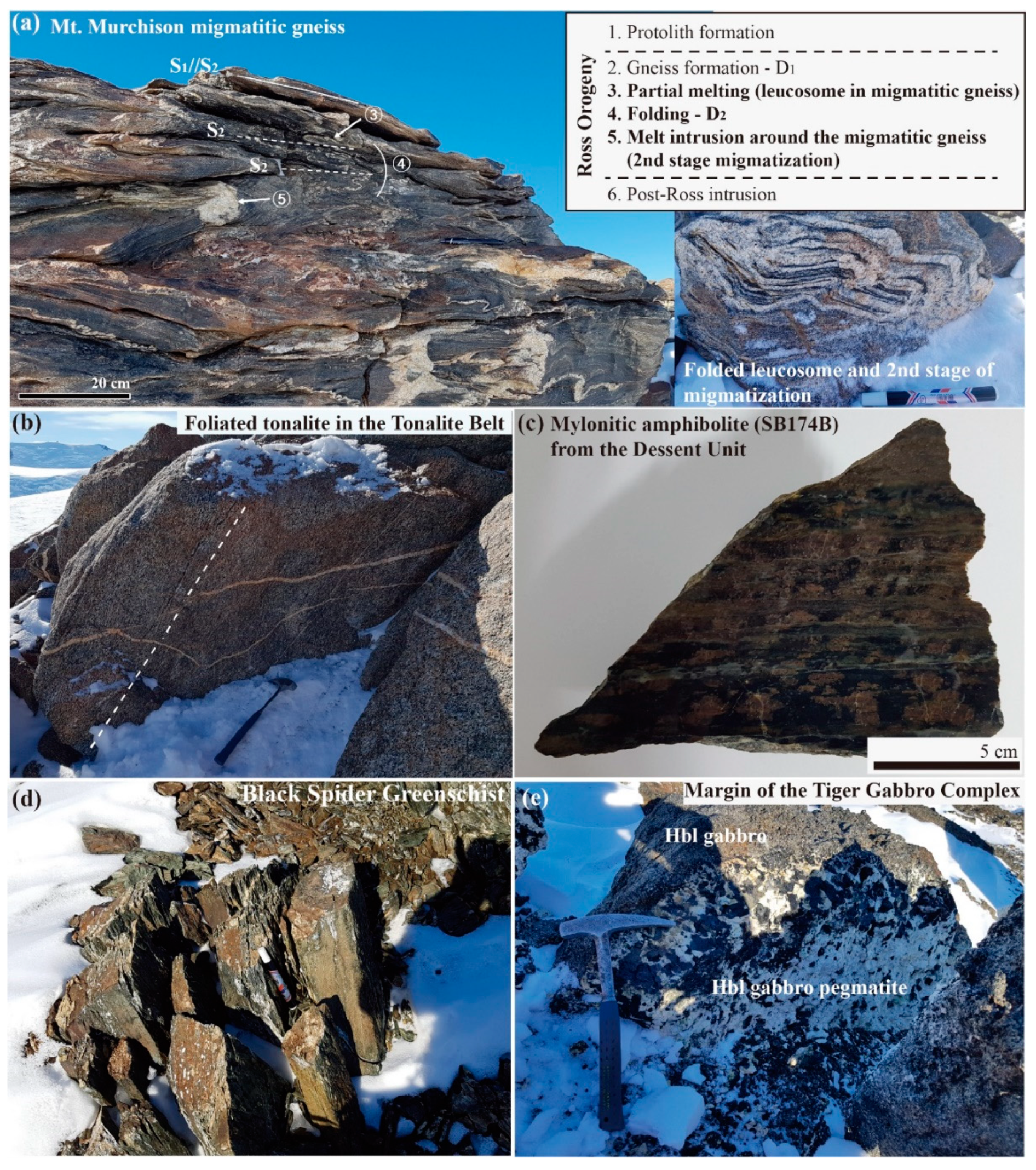
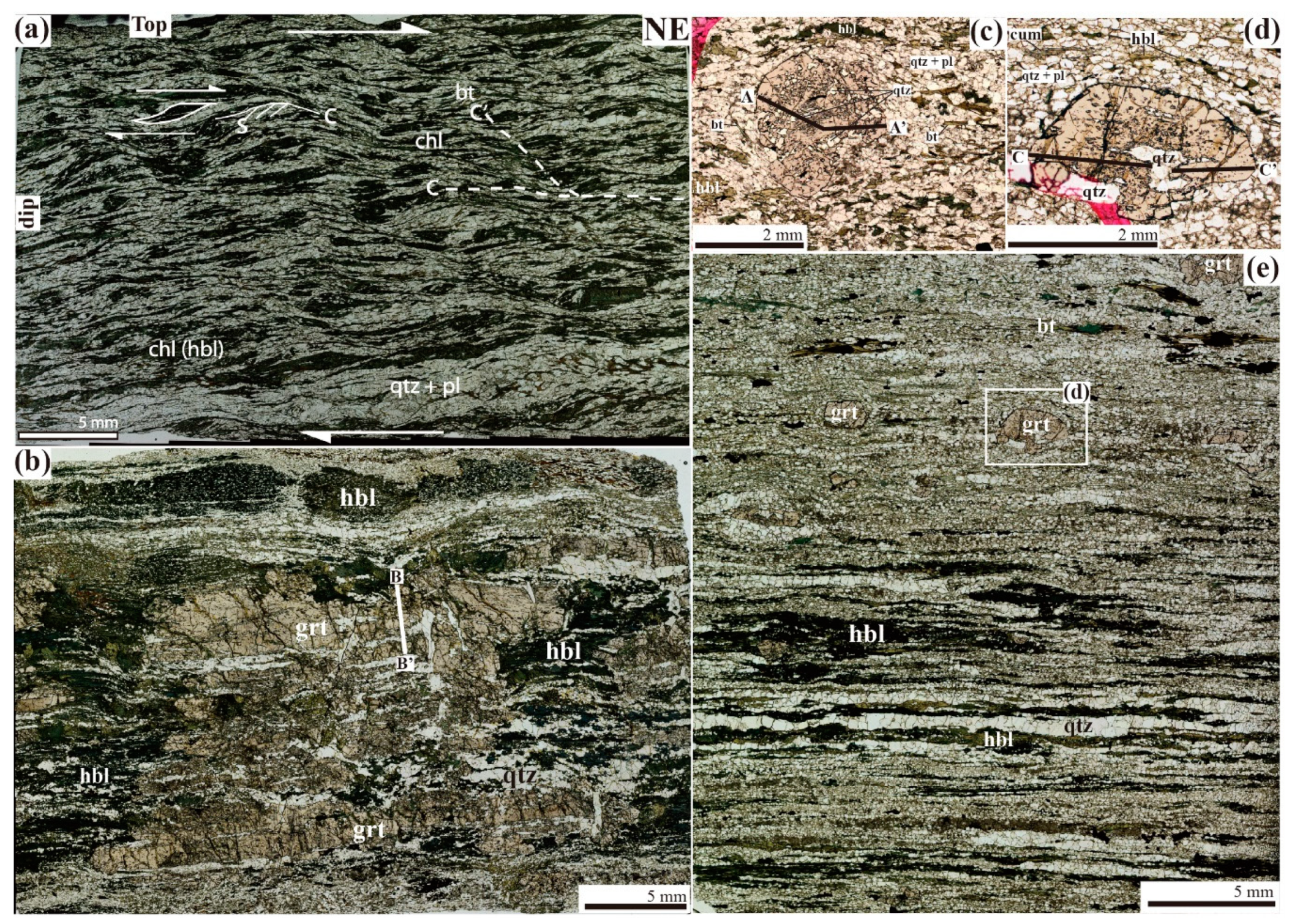



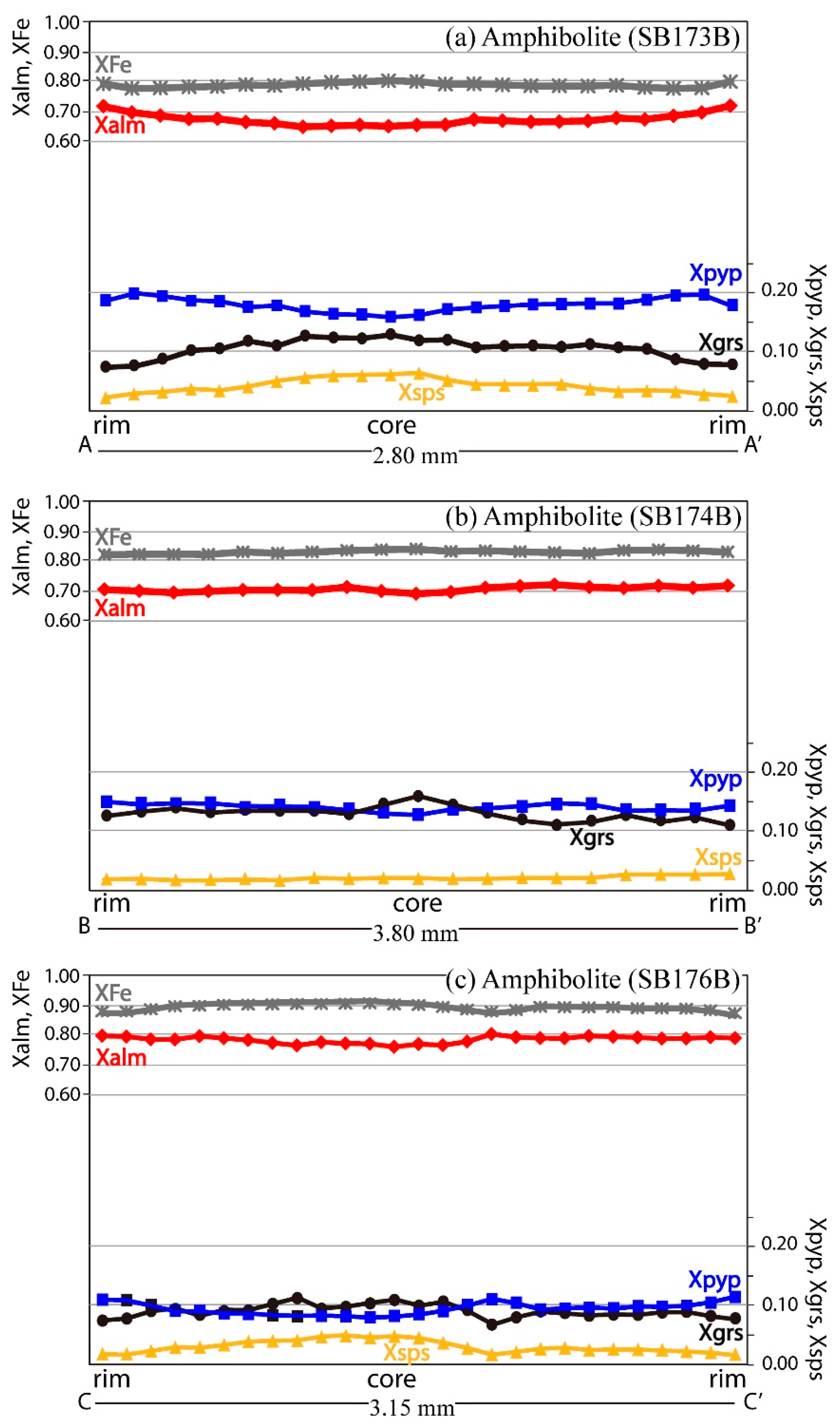
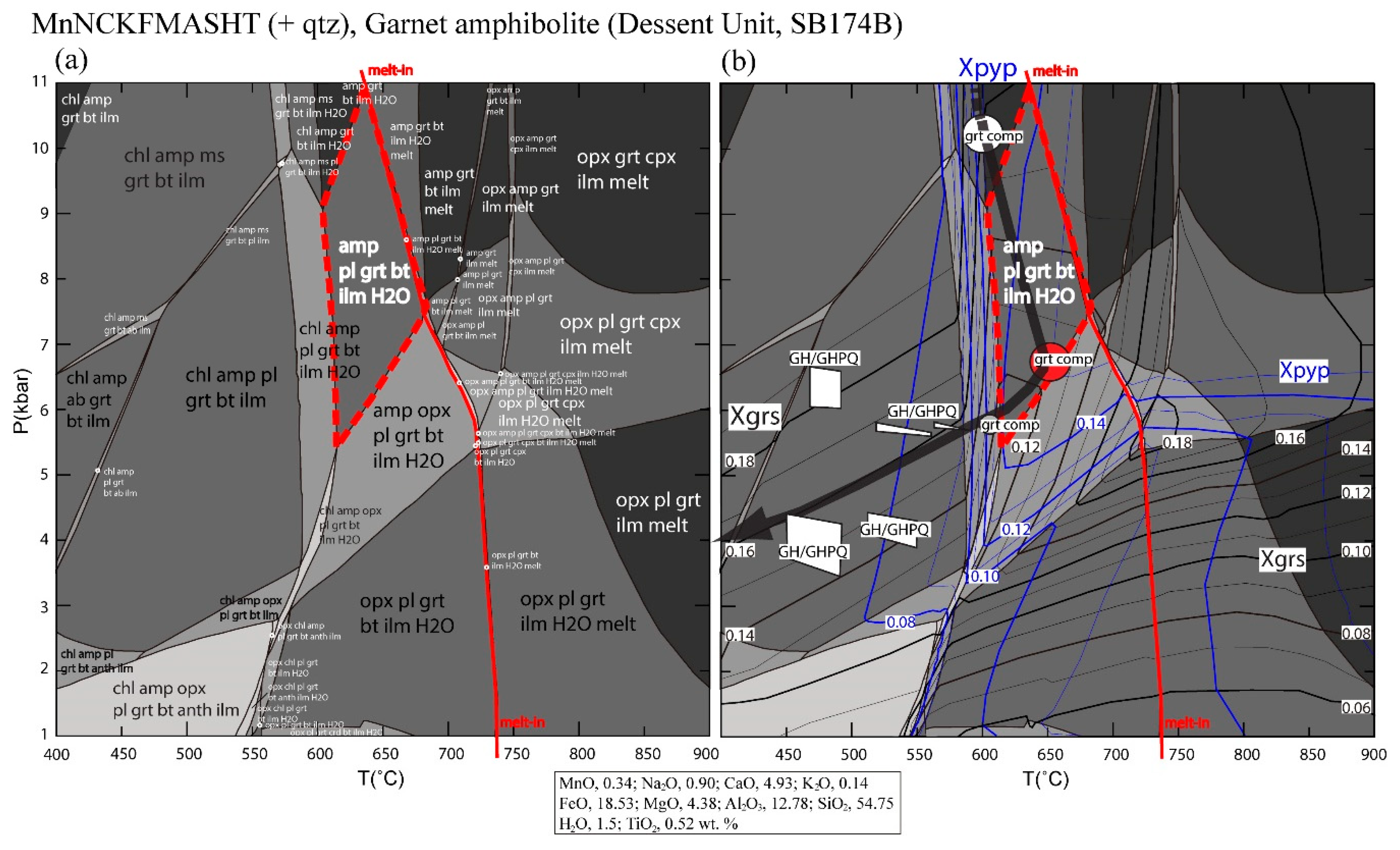
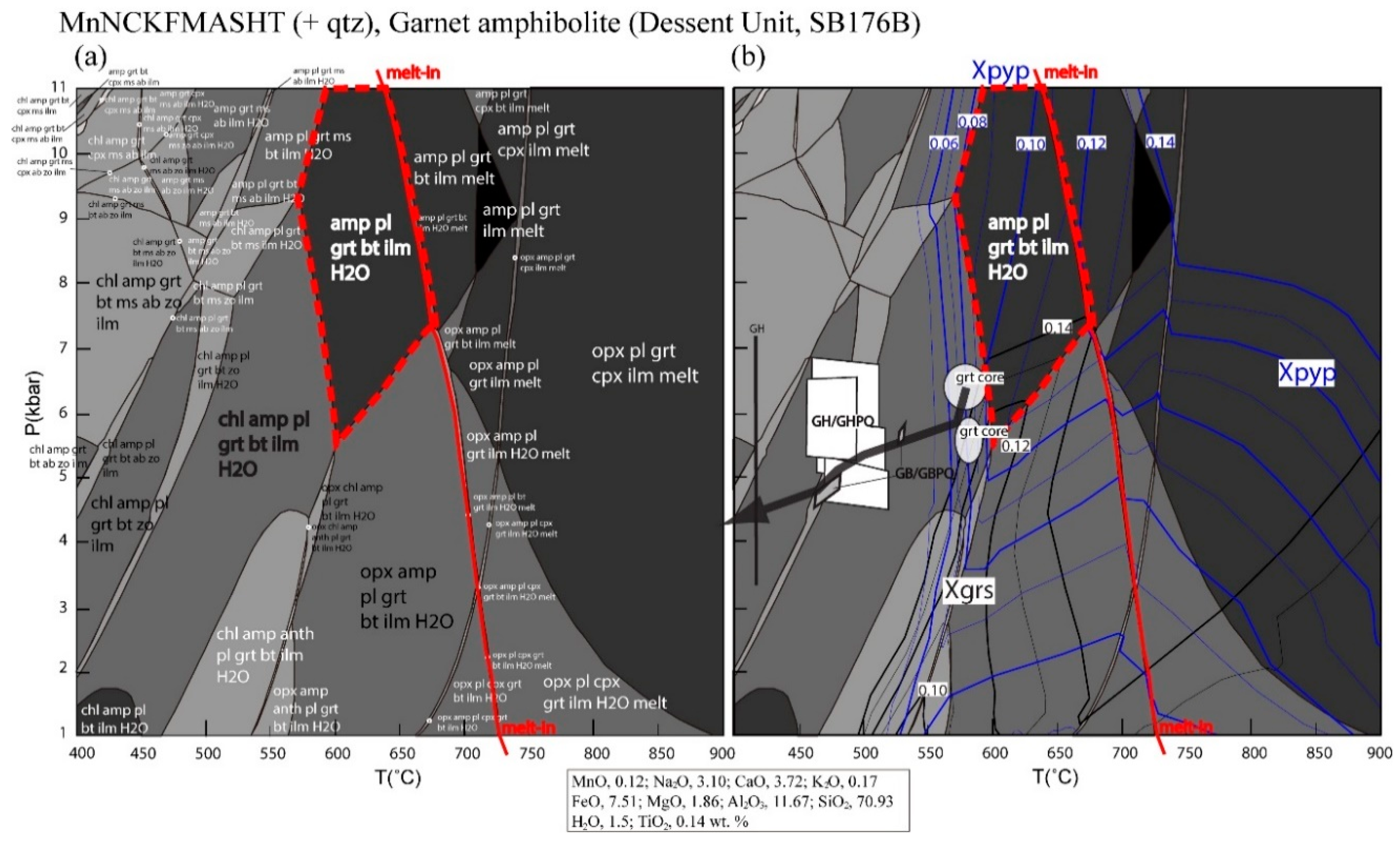
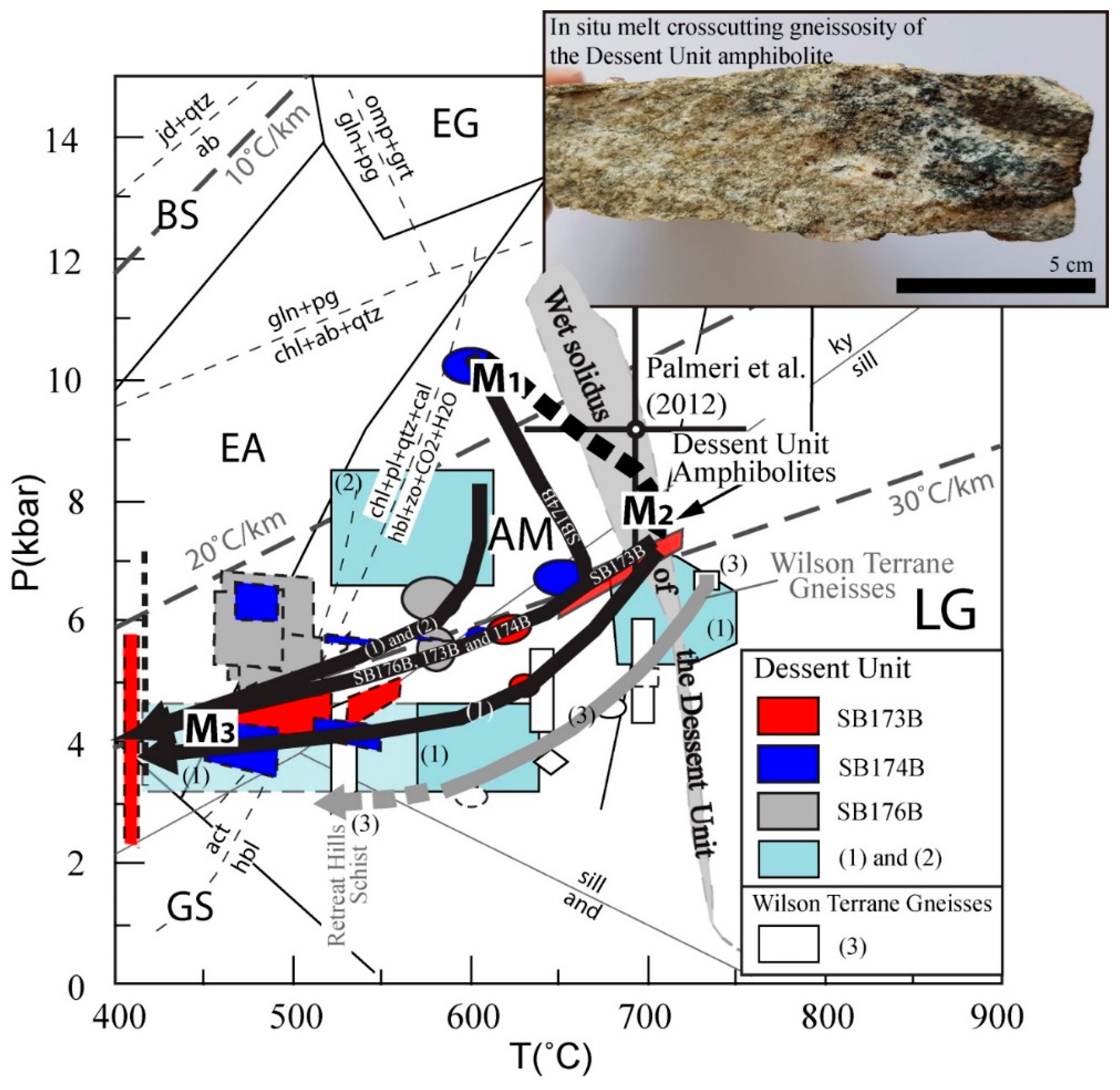

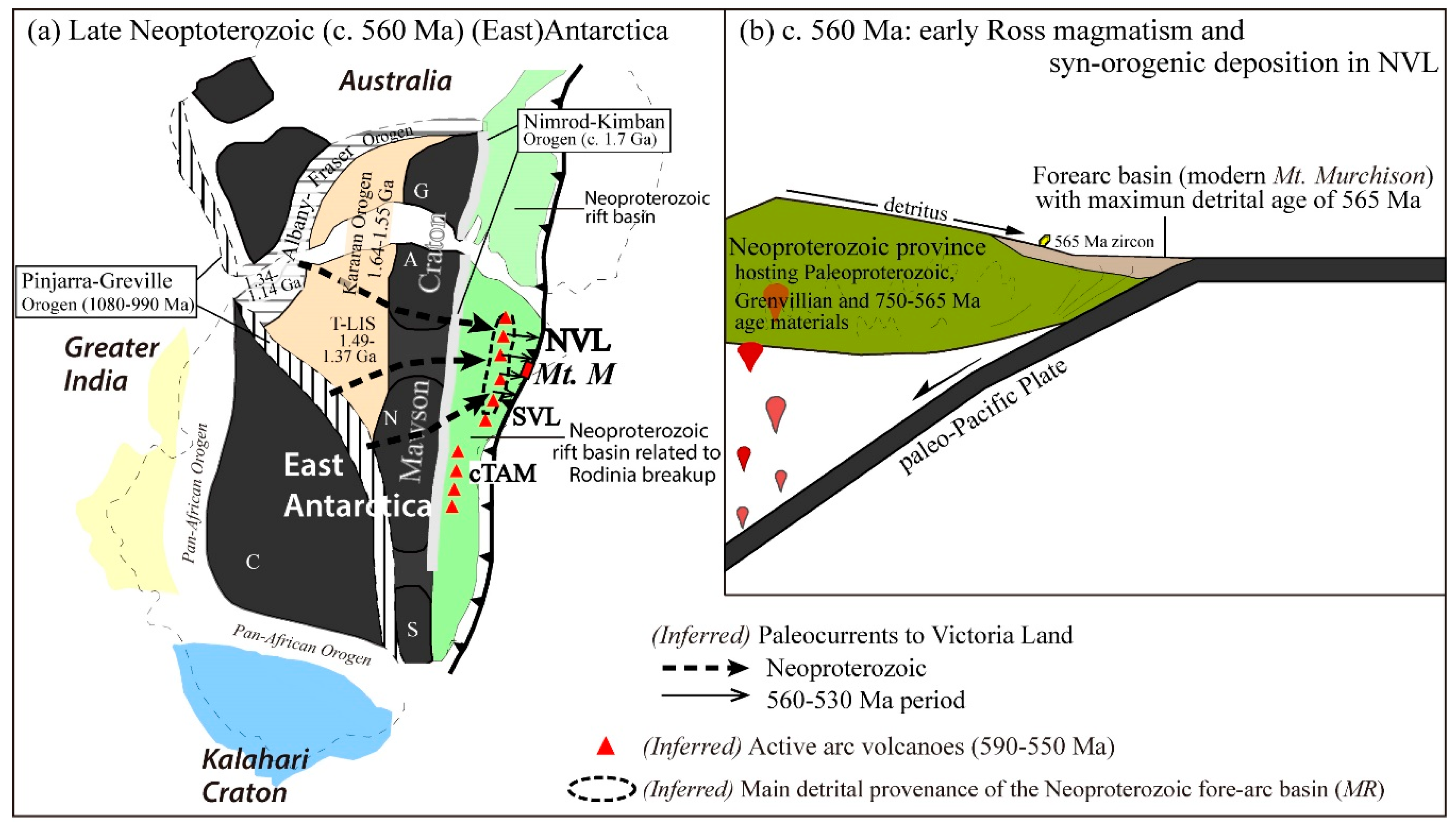

© 2020 by the authors. Licensee MDPI, Basel, Switzerland. This article is an open access article distributed under the terms and conditions of the Creative Commons Attribution (CC BY) license (http://creativecommons.org/licenses/by/4.0/).
Share and Cite
Yi, S.-B.; Lee, M.J.; Lee, J.I.; Kim, H. Timing and Metamorphic Evolution of the Ross Orogeny in and around the Mountaineer Range, Northern Victoria Land, Antarctica. Minerals 2020, 10, 908. https://doi.org/10.3390/min10100908
Yi S-B, Lee MJ, Lee JI, Kim H. Timing and Metamorphic Evolution of the Ross Orogeny in and around the Mountaineer Range, Northern Victoria Land, Antarctica. Minerals. 2020; 10(10):908. https://doi.org/10.3390/min10100908
Chicago/Turabian StyleYi, Sang-Bong, Mi Jung Lee, Jong Ik Lee, and Hwayoung Kim. 2020. "Timing and Metamorphic Evolution of the Ross Orogeny in and around the Mountaineer Range, Northern Victoria Land, Antarctica" Minerals 10, no. 10: 908. https://doi.org/10.3390/min10100908





